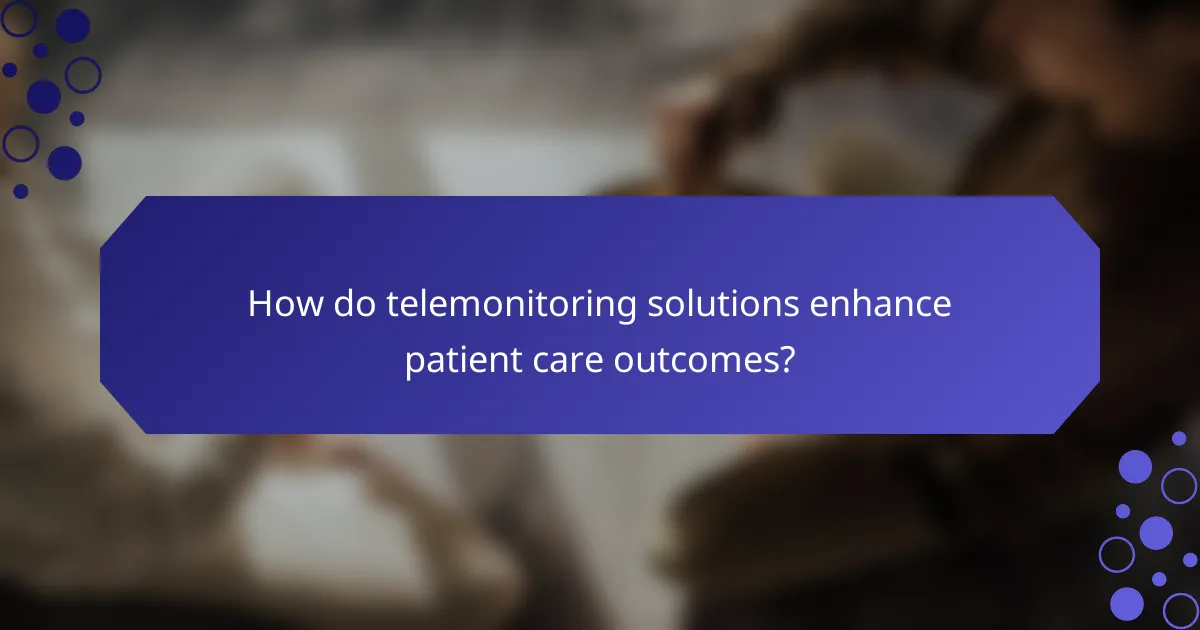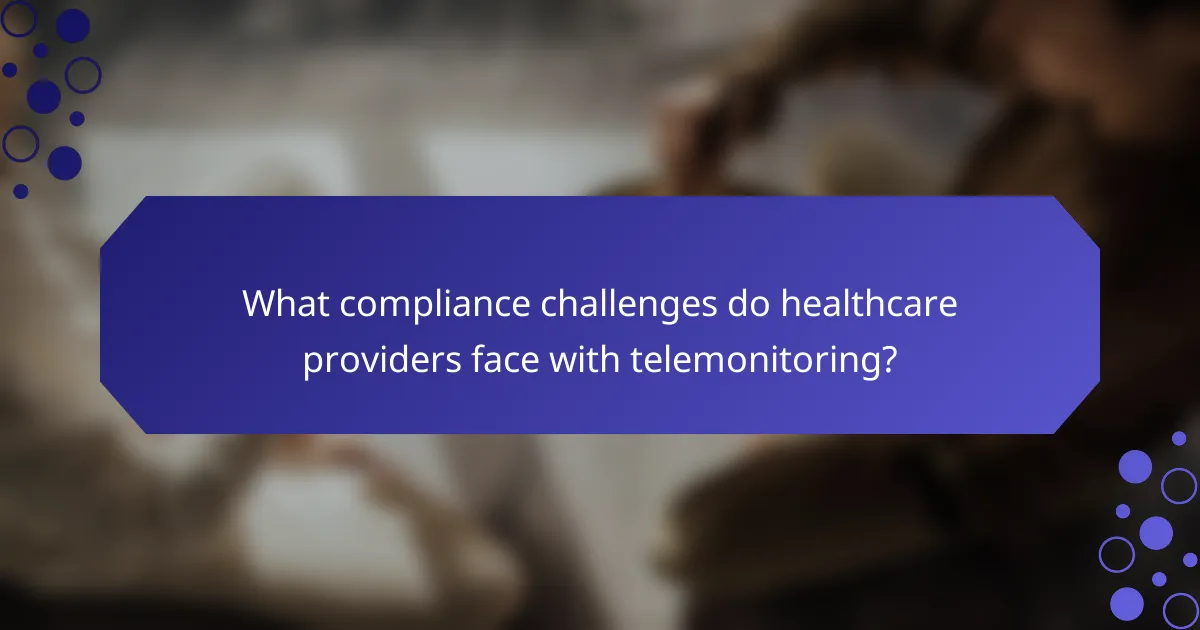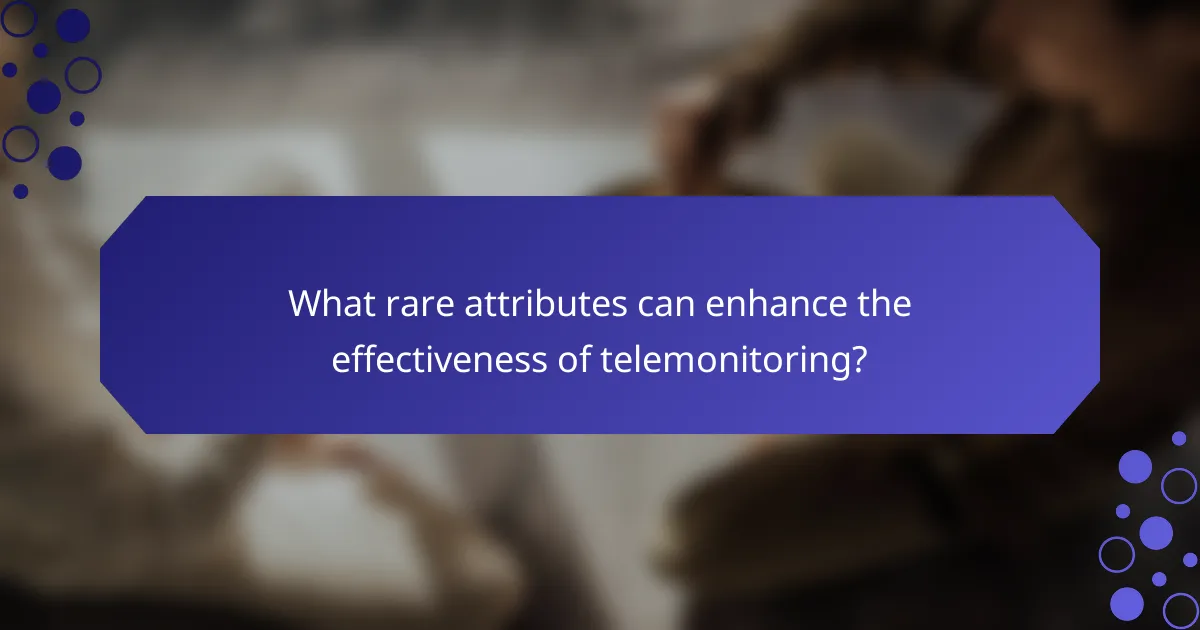Telemonitoring solutions enhance patient care by delivering real-time health data and improving chronic disease management. Innovations like AI-driven analytics and wearable devices increase patient engagement and compliance. However, healthcare providers face challenges such as data privacy, regulatory adherence, and technology integration. These factors significantly influence patient outcomes and the effectiveness of telemonitoring systems.

How do telemonitoring solutions enhance patient care outcomes?
Telemonitoring solutions significantly enhance patient care outcomes by providing real-time health data, improving chronic disease management, and increasing patient engagement. These innovations facilitate timely interventions, reducing hospital readmissions and improving overall health metrics. For instance, studies show that telemonitoring can lower blood pressure in hypertensive patients by 10-15 mmHg. Additionally, compliance challenges arise as patients may struggle with technology usage, necessitating user-friendly interfaces and proper training.
What are the key benefits of telemonitoring for chronic disease management?
Telemonitoring significantly enhances chronic disease management by improving patient outcomes, increasing adherence, and providing real-time data. It enables timely interventions, reduces hospital visits, and empowers patients through self-management. Studies show telemonitoring can lower healthcare costs by up to 30%. Additionally, it fosters better communication between patients and healthcare providers, ensuring personalized care.
How does telemonitoring improve patient engagement and adherence?
Telemonitoring significantly enhances patient engagement and adherence by providing real-time health data. This technology empowers patients to take an active role in their health management, fostering accountability and motivation. For instance, studies show that telemonitoring can improve medication adherence rates by up to 30%. Additionally, it facilitates timely interventions from healthcare providers, addressing potential issues before they escalate. As a result, patients experience better health outcomes and increased satisfaction with their care.
Which technologies are most effective in telemonitoring applications?
Telemonitoring applications benefit from technologies such as wearable devices, mobile health apps, and remote patient monitoring systems. Wearable devices, like smartwatches, provide real-time health data, enhancing patient engagement. Mobile health apps facilitate communication between patients and healthcare providers, improving compliance. Remote patient monitoring systems integrate data from various sources, enabling comprehensive patient assessments. These technologies lead to improved patient outcomes and streamlined healthcare processes.

What innovations are shaping the future of telemonitoring solutions?
Innovations in telemonitoring solutions include remote patient monitoring devices, AI-driven analytics, and integrated health platforms. These advancements enhance patient outcomes by providing real-time data, improving compliance, and enabling proactive care. For example, wearable devices can track vital signs continuously, allowing for immediate intervention when necessary. Additionally, AI algorithms analyze data patterns to predict health issues, thus increasing the effectiveness of telemonitoring. As a result, healthcare providers can deliver personalized care while addressing compliance challenges through automated reminders and patient engagement tools.
How are artificial intelligence and machine learning transforming telemonitoring?
Artificial intelligence and machine learning are significantly enhancing telemonitoring by improving data accuracy, patient engagement, and predictive analytics. These technologies enable real-time monitoring and personalized care, leading to better patient outcomes. For instance, AI algorithms can analyze vast amounts of health data to identify trends and alert healthcare providers to potential issues before they escalate. This proactive approach not only enhances compliance but also reduces hospital readmissions. Additionally, machine learning models adapt to individual patient behaviors, fostering greater adherence to treatment plans. Overall, the integration of these technologies in telemonitoring addresses compliance challenges while optimizing patient care.
What role do wearable devices play in telemonitoring advancements?
Wearable devices significantly enhance telemonitoring by providing real-time health data and improving patient engagement. They enable continuous monitoring of vital signs, facilitating timely interventions. For example, devices track heart rate, blood pressure, and activity levels, which can lead to better health outcomes. Compliance challenges arise as patients may struggle with device usage or data interpretation, impacting overall effectiveness.
Which emerging platforms are leading the telemonitoring market?
Telemonitoring is led by platforms like Teladoc Health, Amwell, and Philips. These companies innovate with remote patient monitoring technologies that enhance patient outcomes and address compliance challenges. Teladoc Health provides integrated solutions, while Amwell focuses on virtual care delivery. Philips emphasizes connectivity and data analytics to improve chronic disease management. These platforms are shaping the future of telemonitoring through advanced analytics and user-friendly interfaces.

What compliance challenges do healthcare providers face with telemonitoring?
Healthcare providers face significant compliance challenges with telemonitoring, including data privacy, regulatory adherence, and technology integration. Ensuring patient data security is paramount, as breaches can lead to severe penalties. Providers must also navigate complex regulations like HIPAA, which dictate how patient information is handled. Additionally, integrating telemonitoring systems with existing healthcare infrastructure can create operational hurdles. These challenges can impact patient outcomes and the overall effectiveness of telemonitoring solutions.
How do privacy regulations impact telemonitoring practices?
Privacy regulations significantly impact telemonitoring practices by enforcing strict data protection measures. These regulations require healthcare providers to ensure patient consent and secure data transmission, which can complicate implementation. Compliance with regulations like HIPAA in the U.S. mandates that telemonitoring solutions incorporate robust encryption and access controls. As a result, organizations must invest in technology that meets these standards, potentially increasing operational costs. Balancing innovation with regulatory compliance remains a key challenge in optimizing patient outcomes through telemonitoring.
What are the common barriers to compliance in telemonitoring?
Common barriers to compliance in telemonitoring include technological issues, patient engagement challenges, and data privacy concerns. Technological barriers often arise from inadequate infrastructure or device malfunctions. Patient engagement can be hindered by a lack of understanding of the system or perceived complexity. Data privacy concerns may discourage patients from fully participating due to fears about their personal health information. Addressing these barriers is crucial for improving adherence and patient outcomes in telemonitoring programs.

Which unique attributes differentiate telemonitoring solutions across regions?
Telemonitoring solutions differ across regions due to variations in technology adoption, regulatory frameworks, and healthcare infrastructure. These factors influence patient engagement, data security, and integration with existing systems.
For example, regions with advanced digital health ecosystems often feature real-time data analytics, while others may rely on basic monitoring tools. Additionally, cultural attitudes towards telehealth can affect patient compliance and acceptance.
These unique attributes shape the effectiveness and accessibility of telemonitoring solutions, ultimately impacting patient outcomes and healthcare delivery.
How do cultural attitudes influence telemonitoring adoption in different areas?
Cultural attitudes significantly impact telemonitoring adoption by influencing perceptions of technology and healthcare. In regions with high trust in medical technology, adoption rates are higher. Conversely, areas with skepticism towards digital solutions may experience resistance. Societal norms and values shape patient expectations and acceptance of telemonitoring, affecting compliance and outcomes. For instance, cultures prioritizing personal interaction may prefer traditional healthcare methods, limiting telemonitoring’s effectiveness. Understanding these cultural dynamics is crucial for tailoring telemonitoring solutions to enhance patient engagement and improve health outcomes.
What unique features are found in telemonitoring solutions for specific patient populations?
Telemonitoring solutions for specific patient populations feature customizable protocols, real-time data analytics, and integrated communication tools. These innovations enhance patient engagement and adherence to treatment plans. For instance, solutions for chronic disease management often include tailored alerts and reminders based on individual patient needs. Unique attributes, such as AI-driven predictive analytics, further optimize patient outcomes by anticipating health issues before they escalate.

What rare attributes can enhance the effectiveness of telemonitoring?
Rare attributes that can enhance the effectiveness of telemonitoring include advanced AI analytics, personalized patient engagement strategies, and integration with wearable technology. These elements enable real-time data interpretation, improve patient adherence, and facilitate seamless communication between patients and healthcare providers. Additionally, unique features like predictive health alerts and customizable dashboards can significantly improve patient outcomes and satisfaction.
How can personalized telemonitoring interventions improve patient outcomes?
Personalized telemonitoring interventions significantly enhance patient outcomes by providing tailored health management. These solutions enable real-time data collection, allowing healthcare providers to adjust treatment plans based on individual needs. For instance, studies show that patients using personalized telemonitoring experience a 20% reduction in hospital readmissions. This approach fosters greater patient engagement and adherence to treatment regimens, ultimately improving overall health metrics. By addressing unique patient conditions, telemonitoring can lead to more effective management of chronic diseases, demonstrating its critical role in modern healthcare.
What innovative partnerships are emerging in the telemonitoring landscape?
Innovative partnerships in the telemonitoring landscape focus on technology integration and improved patient engagement. Collaborations between healthcare providers and tech companies enhance remote patient monitoring capabilities. For example, wearables integrated with telehealth platforms allow real-time data sharing. These partnerships aim to improve patient outcomes and compliance by leveraging data analytics and artificial intelligence.
What best practices should be followed for successful telemonitoring implementation?
Successful telemonitoring implementation requires clear protocols, user training, and robust technology integration. Establishing a structured plan ensures consistent data collection and patient engagement.
1. Define clear objectives for monitoring outcomes and compliance.
2. Train patients and healthcare providers on technology usage.
3. Ensure data security and patient privacy compliance.
4. Regularly evaluate and adjust monitoring protocols based on feedback.
